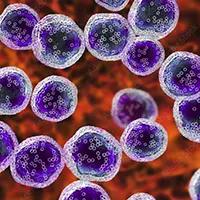Video
Dr. Searle on Initial Results From the MajesTEC-2 Trial in Multiple Myeloma
Author(s):
Emma Searle, MD, discusses early findings from cohort E of the phase 1b MajesTEC-2 trial (NCT04722146) evaluating teclistamab-cqyv (Tecvayli) plus daratumumab (Darzalex) and lenalidomide (Revlimid) in multiple myeloma.
Emma Searle, MD, consultant hematologist, Christie Hospital NHS Foundation Trust, honorary senior lecturer, University of Manchester, Manchester, England, discusses early findings from cohort E of the phase 1b MajesTEC-2 trial (NCT04722146) evaluating teclistamab-cqyv (Tecvayli) plus daratumumab (Darzalex) and lenalidomide (Revlimid) in multiple myeloma.
The combination of daratumumab and lenalidomide plus dexamethasone is currently FDA approved for the treatment of patients with multiple myeloma. The MajesTEC-2 trial aimed to investigate the addition of BCMA and CD3-directed bispecific antibody teclistamab to daratumumab and lenalidomide in heavily pretreated patients with relapsed/refractory multiple myeloma.
Preliminary efficacy data from patients in cohort E showed that the combination elicited a high overall response rate (ORR) and deep remissions, Searle begins. All 13 evaluable patients in the 0.72-mg/kg dosing cohort achieved a response. Although ORR data in the remaining dosing groups are not fully mature, responses were still observed and deepened over time, Searle continues. ORR in the 1.5-mg/kg group is anticipated to continue increasing over time and durability of response will be assessed as the study continues, she says.
Due to the regimen's high potency, safety data were a key aspect of this trial, Searle states. At the time of data cutoff in July 2022, 80.6% of patients remained on treatment, 3 patients had progressed, and 2 patients experienced death due to infection, she says. Furthermore, 90.6% of patients experienced any-grade infection throughout their duration of treatment. Accordingly, it is vital to prevent and monitor against the suspicion of infection, Searle cautions.
No new adverse events (AEs) were reported in the trial and the safety profile was consistent with previously known signals for the individual agents. The most common hematological AE of any grade was neutropenia and 4 patients experienced febrile neutropenia. Cytokine release syndrome (CRS) was a common non-hematologic AE, and 37 patients experienced CRS in cycle 1 of treatment. The median time to onset and median duration of CRS was 2 days. These data indicate that although CRS is a common AE, it is manageable, Searle concludes.









